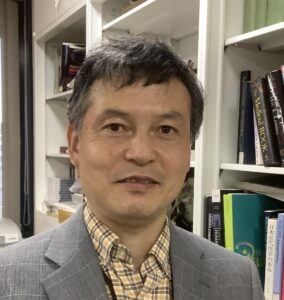
National Institute of Basic Biology
Male gametes must undergo spermatogenesis in the testes and achieve functional maturation in the epididymis to attain their full fertilizing ability. Given that this maturation process must persist throughout the lifespan, our study aims to elucidate the regulatory system for sperm maturation that supports long-term stable reproduction. Specifically, we will elucidate (1) the mechanism of sperm maturation control by the epididymis, and (2) the molecular mechanisms underlying sperm maturation at the molecular level.

Graduate School of Science,
Nagoya University
During the reproductive lifespan, germ cell sex (egg or sperm fate decision) seems an immutable trait. However, the reality is dynamic, as some fish undergo sex reversal during development, shifting from oogenesis to spermatogenesis, while other environmental factors affect germ cell sex. We focus on medaka mutants in which germ cell sex fluctuates with growth, and investigate the molecular mechanisms of this fluctuation and its hierarchical nature (at body/tissue/cell levels), thereby approaching the dynamic nature of the reproductive life span.

Institute of Molecular Embryology and Genetics,
Kumamoto University
Meiotic prophase corresponds to the G2 phase of the cell cycle. The purpose of this study is to elucidate the mechanism that generates the essential difference between the G2 phase and the meiotic prophase.

Center for Advanced Assisted Reproductive Technologies,
University of Yamanashi
In mammals, oocytes are stored in primordial follicles, remaining immature and dormant. Some of them are activated to develop into mature eggs, ensuring continuous ovulation cycles. Consequently, depletion of primordial follicles signifies a loss of reproductive capacity, emphasizing the importance of controlling their dormancy and initiation of maturation in determining female reproductive ability. This study aims to elucidate the mechanisms underlying the acquisition and maintenance of oocyte dormancy in primordial follicles by environmental factors.

Laboratory for epigenetic regulation,
Faculty of Bio-Science,
Nagahama Institute of Bio-Science and Technology.
Zygotic genome activation (ZGA) is a critical event in development, when the paternally derived genome and maternally derived genome begin to be activated and transcribed after fertilization. In this study, we aim to elucidate the molecular mechanism that initiates ZGA through functional analysis of Glis3, a transcription factor involved in the regulation of ZGA that we have recently identified.

Gunma University,
Institute for Molecular and Cellular Regulation
In this study, we try to elucidate endosomal/lysosomal activation mechanisms mediated by germ granule (P granule) components during oocyte-to-embryo transition in C. elegans.

Lab. Functional Non-coding Genomics,
RIKEN Center for Integrative Medical Sciences
It is well known that the expression levels of transposons undergo significant changes, particularly during embryonic development. While it has been demonstrated that regulating transposons by various mechanisms is essential for proper development, it remains unclear how transposon repression contributes to normal development. This study aims to provide evidence for the hypothesis that the antagonism between transposon expression and its regulatory mechanisms ensures the quality of germ cells.

Department of Biological Sciences,
Graduate School of Science,
The University of Tokyo
Egg quality varies with multiple factors including lifespan progression. Actin is thought to contribute to egg quality, though specific insights are scarce. Our study focuses on cytoplasmic streaming, a distinctive actin function in oocytes. By elucidating the mechanism of cytoplasmic streaming in mouse unfertilized and fertilized eggs and examining the relationship between streaming and developmental potential, we aim to explore the potential of cytoplasmic streaming as an indicator of egg quality.

Department of Veterinary Anatomy,
The University of Tokyo
In mammalian convoluted seminiferous tubules, spermatogenic stem cells (SSCs) migrate within the basal compartment and are not spatially restricted to a specific region (‘open’ niche), leading to the possible selfish clonal selection of SSCs in aging. In the Sertoli valve (SV) niche at the terminal end of the seminiferous tubules, a very few SSCs are stably maintained (‘closed’ niche), as in the Drosophila testis. We will investigate the characteristics of SSCs in the SV niche and compare them with SSCs in the convoluted seminiferous tubules to access the biological significance of two niches.
-227x300.jpg)
Department of Molecular Biosciences,
Radiation Effects Research Foundation
It is important to understand how genomic information is maintained and altered through the germline and passed on to the next generation. We have been breeding laboratory mice for over 60 generations of passages to date. Our study of transgenerational genomic changes in those lineages revealed that large-scale structural changes occur more frequently than expected. We hope to contribute to the advancement of this research area from the viewpoint of the inheritance of genome information across generations.

Life Science Center for Survival Dynamics,
University of Tsukuba
To accurately transmit genomic information to the next generation, the germline represses transposon expression. Here, we test the hypothesis that the germline cells with low germ plasm uptake fail to repress transposon expression. We further examine the mechanisms for germline development.

Dept of Mol Genet,
Grad Sch of Med,
Kyoto Univ
In Japan, approximately one in eleven individuals is born through assisted reproductive technology. Intracytoplasmic sperm injection (ICSI) is utilized in about 70% of cases due to its ability to generate offspring from small amounts of sperm. However, its safety has been questioned as it has only been clinically applied in a few cases, resulting in the birth of only two rabbits and two calves. Last year, we discovered a high incidence of abnormalities in the grandchildren of individuals conceived through ICSI. This study aims to analyze the effects of ICSI on aging and prevent such abnormalities.
_石川祐_1-e1714109439813-341x300.png)
Department of Regenerative Medicine,
Graduate School of Medicine,
Yokohama City University, Japan
As a non-human primate, the monkey (Crab-eating macaque) has been used in many studies, yet it remains unclear how spermatogenesis progresses. Since spermatogenesis has been able to be induced in vitro using immature mouse testes, in vitro culture is now being adapted for testes of other animal species. In this study, we aim to investigate the factors involved in the ‘initiation’ of spermatogenesis using an in vitro culture system and to understand the process of spermatogenesis in primates such as humans and monkeys.

Department of Aging Science and Medicine,
Graduate School of Medicine,
Kyoto University;
The Hakubi Center,
Kyoto University
Meiotic recombination ensures chromosome segregation and promotes genetic diversity of gametes. It changes with age with largely unknown mechanisms. Where, when, and how often genomic damage occurs, leading to mutations and reduced germline quality, is largely unresolved. This study contributes to solve those problems by developing a method to detect recombination and genomic damage sensitively.

Institute for quantitative biosciences,
The University of Tokyo
PIWI-interacting RNAs (piRNAs) are epigenetic mediators important for species preservation. In this study, we aim to verify the dynamics of maternal piRNA-mediated epigenetic inheritance throughout “reproductive lifespan” by creating a breakthrough in single-cell parallel piRNA measurements.